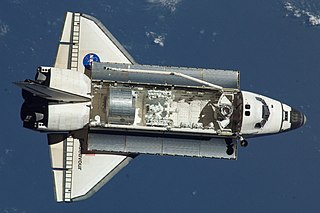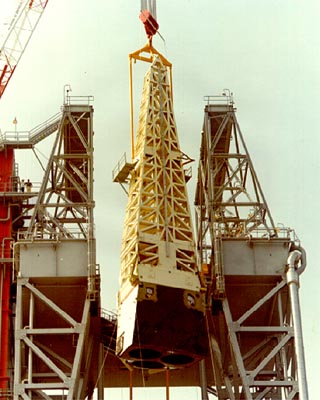
The Space Shuttle is a retired, partially reusable low Earth orbital spacecraft system operated from 1981 to 2011 by the U.S. National Aeronautics and Space Administration (NASA) as part of the Space Shuttle program. Its official program name was Space Transportation System (STS), taken from a 1969 plan for a system of reusable spacecraft where it was the only item funded for development.

Space Shuttle Challenger (OV-099) was a Space Shuttle orbiter manufactured by Rockwell International and operated by NASA. Named after the commanding ship of a nineteenth-century scientific expedition that traveled the world, Challenger was the second Space Shuttle orbiter to fly into space after Columbia, and launched on its maiden flight in April 1983. It was destroyed in January 1986 soon after launch in an accident that killed all seven crewmembers aboard. Initially manufactured as a test article not intended for spaceflight, it was utilized for ground testing of the Space Shuttle orbiter's structural design. However, after NASA found that their original plan to upgrade Enterprise for spaceflight would be more expensive than upgrading Challenger, the orbiter was pressed into operational service in the Space Shuttle program. Lessons learned from the first orbital flights of Columbia led to Challenger's design possessing fewer thermal protection system tiles and a lighter fuselage and wings. This led to it being 1,000 kilograms lighter than Columbia, though still 2,600 kilograms heavier than Discovery.

Space Shuttle Enterprise was the first orbiter of the Space Shuttle system. Rolled out on September 17, 1976, it was built for NASA as part of the Space Shuttle program to perform atmospheric test flights after being launched from a modified Boeing 747. It was constructed without engines or a functional heat shield. As a result, it was not capable of spaceflight.

Space Shuttle Columbia (OV-102) was a Space Shuttle orbiter manufactured by Rockwell International and operated by NASA. Named after the first American ship to circumnavigate the upper North American Pacific coast and the female personification of the United States, Columbia was the first of five Space Shuttle orbiters to fly in space, debuting the Space Shuttle launch vehicle on its maiden flight in April 1981. As only the second full-scale orbiter to be manufactured after the Approach and Landing Test vehicle Enterprise, Columbia retained unique features indicative of its experimental design compared to later orbiters, such as test instrumentation and distinctive black chines. In addition to a heavier fuselage and the retention of an internal airlock throughout its lifetime, these made Columbia the heaviest of the five spacefaring orbiters; around 1,000 kilograms heavier than Challenger and 3,600 kilograms heavier than Endeavour. Columbia also carried ejection seats based on those from the SR-71 during its first six flights until 1983, and from 1986 onwards carried an imaging pod on its vertical stabilizer.

Space Shuttle Discovery is a retired American spacecraft. The spaceplane was one of the orbiters from NASA's Space Shuttle program and the third of five fully operational orbiters to be built. Its first mission, STS-41-D, flew from August 30 to September 5, 1984. Over 27 years of service it launched and landed 39 times, aggregating more spaceflights than any other spacecraft to date. The Space Shuttle launch vehicle had three main components: the Space Shuttle orbiter, a single-use central fuel tank, and two reusable solid rocket boosters. Nearly 25,000 heat-resistant tiles cover the orbiter to protect it from high temperatures on re-entry.

Space Shuttle Endeavour is a retired orbiter from NASA's Space Shuttle program and the fifth and final operational Shuttle built. It embarked on its first mission, STS-49, in May 1992 and its 25th and final mission, STS-134, in May 2011. STS-134 was expected to be the final mission of the Space Shuttle program, but with the authorization of STS-135 by the United States Congress, Atlantis became the last shuttle to fly.

The Space Shuttle program was the fourth human spaceflight program carried out by the U.S. National Aeronautics and Space Administration (NASA), which accomplished routine transportation for Earth-to-orbit crew and cargo from 1981 to 2011. Its official name, Space Transportation System (STS), was taken from a 1969 plan for a system of reusable spacecraft of which it was the only item funded for development. It flew 135 missions and carried 355 astronauts from 16 countries, many on multiple trips.

The Hubble Space Telescope is a space telescope that was launched into low Earth orbit in 1990 and remains in operation. It was not the first space telescope, but it is one of the largest and most versatile, renowned both as a vital research tool and as a public relations boon for astronomy. The Hubble telescope is named after astronomer Edwin Hubble and is one of NASA's Great Observatories. The Space Telescope Science Institute (STScI) selects Hubble's targets and processes the resulting data, while the Goddard Space Flight Center (GSFC) controls the spacecraft.

The George C. Marshall Space Flight Center (MSFC), located in Redstone Arsenal, Alabama, is the U.S. government's civilian rocketry and spacecraft propulsion research center. As the largest NASA center, MSFC's first mission was developing the Saturn launch vehicles for the Apollo program. Marshall has been the lead center for the Space Shuttle main propulsion and external tank; payloads and related crew training; International Space Station (ISS) design and assembly; computers, networks, and information management; and the Space Launch System. Located on the Redstone Arsenal near Huntsville, MSFC is named in honor of General of the Army George C. Marshall.

The Space Shuttle Pathfinder is a Space Shuttle test simulator made of steel and wood. Constructed by NASA in 1977 as an unnamed facilities test article, it was purchased in the early 1980s by the America-Japan Society, Inc. which had it refurbished, named it, and placed it on display in the Great Space Shuttle Exhibition in Tokyo. The mockup was later returned to the United States and placed on permanent display at the U.S. Space & Rocket Center in Huntsville, Alabama, in May 1988.

John Mace Grunsfeld is an American physicist and a former NASA astronaut. He is a veteran of five Space Shuttle flights and has served as NASA Chief Scientist. His academic background includes research in high energy astrophysics, cosmic ray physics and the emerging field of exoplanet studies with specific interest in future astronomical instrumentation. After retiring from NASA in 2009, he served as the deputy director of the Space Telescope Science Institute in Baltimore, Maryland. In January 2012, he returned to NASA and served as associate administrator of NASA's Science Mission Directorate (SMD). Grunsfeld announced his retirement from NASA in April 2016.

The Wide Field and Planetary Camera 2 (WFPC2) is a camera formerly installed on the Hubble Space Telescope. The camera was built by the Jet Propulsion Laboratory and is roughly the size of a baby grand piano. It was installed by servicing mission 1 (STS-61) in 1993, replacing the telescope's original Wide Field and Planetary Camera (WF/PC). WFPC2 was used to image the Hubble Deep Field in 1995, the Engraved Hourglass Nebula and Egg Nebula in 1996, and the Hubble Deep Field South in 1998. During STS-125, WFPC2 was removed and replaced with the Wide Field Camera 3 as part of the mission's first spacewalk on May 14, 2009. After returning to Earth, the camera was displayed briefly at the National Air and Space Museum and the Jet Propulsion Laboratory before returning to its final home at the Smithsonian's National Air and Space Museum.

The Main Propulsion Test Article (MPTA-098) was built by Rockwell International as a testbed for the definitive propulsion and fuel delivery systems for the U.S. Space Shuttle Program.

The Ares V was the planned cargo launch component of the cancelled NASA Constellation program, which was to have replaced the Space Shuttle after its retirement in 2011. Ares V was also planned to carry supplies for a human presence on Mars. Ares V and the smaller Ares I were named after Ares, the Greek god of war.

A boilerplate spacecraft, also known as a mass simulator, is a nonfunctional craft or payload that is used to test various configurations and basic size, load, and handling characteristics of rocket launch vehicles. It is far less expensive to build multiple, full-scale, non-functional boilerplate spacecraft than it is to develop the full system. In this way, boilerplate spacecraft allow components and aspects of cutting-edge aerospace projects to be tested while detailed contracts for the final project are being negotiated. These tests may be used to develop procedures for mating a spacecraft to its launch vehicle, emergency access and egress, maintenance support activities, and various transportation processes.

STS-125, or HST-SM4, was the fifth and final Space Shuttle mission to the Hubble Space Telescope (HST) The launch of the Space Shuttle Atlantis occurred on May 11, 2009, at 2:01 pm EDT. Landing occurred on May 24 at 11:39 am EDT, with the mission lasting a total of just under 13 days.

The Space Shuttle orbiter is the spaceplane component of the Space Shuttle, a partially reusable orbital spacecraft system that was part of the discontinued Space Shuttle program. Operated from 1977 to 2011 by NASA, the U.S. space agency, this vehicle could carry astronauts and payloads into low Earth orbit, perform in-space operations, then re-enter the atmosphere and land as a glider, returning its crew and any on-board payload to the Earth.

The Saturn V dynamic test vehicle, designated SA-500D, is a prototype Saturn V rocket used by NASA to test the performance of the rocket when vibrated to simulate the shaking which subsequent rockets would experience during launch. It was the first full-scale Saturn V completed by the Marshall Space Flight Center (MSFC). Though SA-500D never flew, it was instrumental in the development of the Saturn V rocket which propelled the first men to the Moon as part of the Apollo program. Built under the direction of Dr. Wernher von Braun, it served as the test vehicle for all of the Saturn support facilities at MSFC.

The Stafford Air & Space Museum is located in Weatherford, Oklahoma, United States. The museum, named for NASA astronaut and Weatherford native Thomas P. Stafford, became a Smithsonian Affiliate in June 2010. The museum features exhibits about aviation, space exploration, and rocketry, and a collection of over 20 historic aircraft. Displays include Stafford's Apollo 10 spacesuit, the Gemini 6A spacecraft, artifacts from the Space Shuttle program, the Hubble Space Telescope, and the Mir Space Station, a Moon rock, a Titan II missile, and a Mark 6 re-entry vehicle.



















